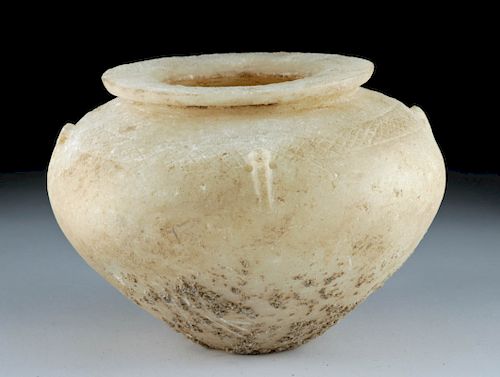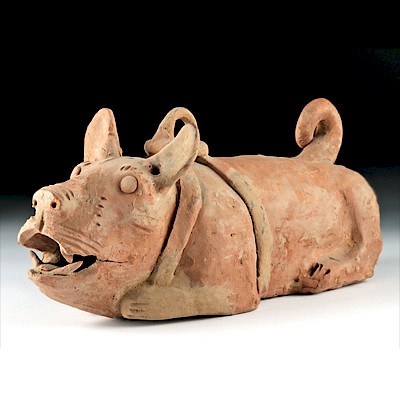Egyptian Early Dynastic Alabaster Bowl
Lot 1a
About Seller
Artemis Fine Arts
686 S Taylor Ave, Ste 106
Louisville, CO 80027
United States
Selling antiquities, ancient and ethnographic art online since 1993, Artemis Gallery specializes in Classical Antiquities (Egyptian, Greek, Roman, Near Eastern), Asian, Pre-Columbian, African / Tribal / Oceanographic art. Our extensive inventory includes pottery, stone, metal, wood, glass and textil...Read more
Estimate:
$3,500 - $5,500
Absentee vs Live bid
Two ways to bid:
- Leave a max absentee bid and the platform will bid on your behalf up to your maximum bid during the live auction.
- Bid live during the auction and your bids will be submitted real-time to the auctioneer.
Bid Increments
| Price | Bid Increment |
|---|---|
| $0 | $25 |
| $300 | $50 |
| $1,000 | $100 |
| $2,000 | $250 |
| $5,000 | $500 |
| $10,000 | $1,000 |
| $20,000 | $2,500 |
| $50,000 | $5,000 |
| $100,000 | $10,000 |
| $200,000 | $20,000 |
About Auction
By Artemis Fine Arts
Sep 13, 2018
Set Reminder
2018-09-13 10:00:00
2018-09-13 10:00:00
America/New_York
Bidsquare
Bidsquare : Ancient | Asian | Ethnographic - Fall Variety
https://www.bidsquare.com/auctions/artemis-gallery/ancient-asian-ethnographic---fall-variety-3432
Travel the world and back in time... Antiquities from Egypt, Greece, Italy and the Near East, Asian, Pre-Columbian, African / Tribal / Oceanic, Native American, Spanish Colonial, Russian Icons, Fine Art, much more! Artemis Fine Arts info@artemisfinearts.com
Travel the world and back in time... Antiquities from Egypt, Greece, Italy and the Near East, Asian, Pre-Columbian, African / Tribal / Oceanic, Native American, Spanish Colonial, Russian Icons, Fine Art, much more! Artemis Fine Arts info@artemisfinearts.com
- Lot Description
Ancient Egypt, Early Dynastic Period, 1st to 2nd Dynasty, ca. 3150 to 2686 BCE. A simple yet elegant hand-carved alabaster bowl of a sizable form with a globular body which gradually tapers to a petite flat base. The upper body boasts an incised lattice-patterned band around the sloping shoulder which is interrupted only by a quartet of pierced lug handles. The underside of the discoid rim is carved away, and the topside gently slopes inwards to a deep interior. An exquisite example of early Egyptian craftsmanship! Size: 7.75" W x 5.2" H (19.7 cm x 13.2 cm).
Alabaster was quarried along the length of the Nile, from Giza to just south of Luxor. Offering vessels made of alabaster were used in temples and placed in the tombs of people at all class levels. For example, Auguste Mariette, the famous French Egyptologist of the 19th century, found a cemetery for the poor in Memphis where the dead had been buried without wrappings only three feet below the ground - but each had a small alabaster bowl and some animal bones, as they had been given food and drink for the afterlife. Meanwhile, kings were buried with many alabaster objects, often of the highest quality, necessary to provide for them during their time in the underworld.
Provenance: private East Coast, USA collection
All items legal to buy/sell under U.S. Statute covering cultural patrimony Code 2600, CHAPTER 14, and are guaranteed to be as described or your money back.
A Certificate of Authenticity will accompany all winning bids.
We ship worldwide and handle all shipping in-house for your convenience.
#138438Surface wear and abrasions commensurate with age, small loss to rim, minor nicks to body, rim, and base, fading to incised panel on shoulder, and roughness across most surfaces. Nice earthen deposits and encrustations throughout.Condition
- Shipping Info
-
All shipping is handled in-house for your convenience. Your invoice from Artemis Gallery will include shipping calculation instructions. If in doubt, please inquire BEFORE bidding for estimated shipping costs for individual items.
-
- Buyer's Premium



 EUR
EUR CAD
CAD AUD
AUD GBP
GBP MXN
MXN HKD
HKD CNY
CNY MYR
MYR SEK
SEK SGD
SGD CHF
CHF THB
THB














